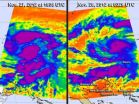(Press-News.org) Tropical Storm Bopha continues to intensify in the western North Pacific Ocean as it heads toward Yap State, triggering more warnings and watches. Infrared imagery from NASA's Aqua satellite captured over two days revealed that the storm had consolidated, intensified and developed a large band of strong thunderstorms south of the center, that resemble a tail.
Infrared images of Tropical Storm Bopha were taken by the AIRS instrument on NASA's Aqua satellite on Nov. 27 at 1505 UTC when Bopha had maximum sustained winds near 45 mph, and on Nov. 28 at 0329 UTC when Bopha's winds increased to 65 mph. The highest, coldest, strongest thunderstorms with heavy rainfall were tightly wrapped around Bopha's center of circulation, and in a newly developed, more organized band of strong thunderstorms south of the storm's center. That large band of thunderstorms resembles a tail to the storm that drapes from the Bismarck Sea, southwest of the storm's center, east to Nauru.
A tropical storm warning remains in effect for Lukunor and the Southern Mortlocks in Chuuk State, Puluwat in Chuuk State and Satawal in Yap State. Heavy rainfall, tropical-storm-force winds, and ocean swells between 1 and 2 feet can be expected in warning areas. The National Weather Service noted that Bopha is generating 10 to 12 foot swells near the center which will result in hazardous surf of 12 to 14 feet along eastern and southeastern and southern shores of Lukunor and nearby islands today, Nov. 28.
A typhoon watch remains in effect for Woleai in Yap state, and a tropical storm watch remains in effect for Faraulep in Yap state.
On Nov. 28, at 10 p.m. CHST local time (1300 UTC/8 a.m. EDT/U.S.), Tropical Storm Bopha's maximum sustained winds had increased to 65 mph, and the storm is moving west at 10 mph. According to the National Weather Service in Guam, "That general motion is expected to continue over the next 24 hours. Tropical Storm Bopha is expected to continue intensifying and may become a typhoon Thursday afternoon, Nov. 29."
At 7 p.m. CHST (0900 UTC/4 a.m. EDT/U.S.) the center of Tropical Storm Bopha was near latitude 5.0 degrees north and longitude 152.5 degrees east. That put the center about 135 miles west-southwest of Lukunor, 175 miles south of Weno Island, Chuuk, and 255 miles southeast of Puluwat. Tropical storm force winds extend outward up to 50 miles from the center, making the storm over 100 miles in diameter.
INFORMATION:
For detailed information about what each island can expect, visit the National Weather Service Office statement: http://www.prh.noaa.gov/data/GUM/HLSPQ1
Infrared NASA imagery sees Tropical Storm Bopha grow a tail
2012-11-29
ELSE PRESS RELEASES FROM THIS DATE:
NASA's Cassini sees abrupt turn in Titan's atmosphere
2012-11-29
Data from NASA's Cassini spacecraft tie a shift in seasonal sunlight to a wholesale reversal, at unexpected altitudes, in the circulation of the atmosphere of Saturn's moon Titan. At the south pole, the data show definitive evidence for sinking air where it was upwelling earlier in the mission. So the key to circulation in the atmosphere of Saturn's moon Titan turned out to be a certain slant of light. The paper was published today in the journal Nature.
"Cassini's up-close observations are likely the only ones we'll have in our lifetime of a transition like this in action," ...
Study IDs kerosene lamps as big source of black carbon
2012-11-29
Berkeley — The primary source of light for more than a billion people in developing nations is also churning out black carbon at levels previously overlooked in greenhouse gas estimates, according to a new study led by researchers at the University of California, Berkeley, and the University of Illinois.
Results from field and lab tests found that 7 to 9 percent of the kerosene in wick lamps — used for light in 250-300 million households without electricity — is converted to black carbon when burned. In comparison, only half of 1 percent of the emissions from burning ...
Significant progress in intelligent radio-over-fiber (I-ROF) systems
2012-11-29
Driven by the strong demand for high-definition video, digital health services, the Internet of Things, and virtual reality, broadband, ubiquitous and convergent information access has become the most important engine to drive the development of the modern information society. With increasing numbers of information-based interactions among humans, machines and objects, especially as new services, new terminals and new needs emerge, the networks are required to provide flexible, energy-efficient, safe and broadband access services anywhere at any time, and therefore wideband ...
The neural toxicity of lanthanides: An update and interpretations
2012-11-29
Lanthanides comprise a unique and dominant resource of China. The increase in contact for populations through lanthanide mining and the wide applications for industry, agriculture, and medicine have raised great public concern regarding the metal toxicity of lanthanides, particularly on the issue of whether lanthanides are toxic to the human nervous system.
In the past decade, major progresses have been made toward elucidating the mechanisms of the biological actions of lanthanides. A recently published review by researchers at Peking University [Xia et al., Sci. China ...
An engraved stone artifact found at the Shuidonggou Paleolithic site, northwest China
2012-11-29
The origin and dispersal of modern humans and modern human behavior are key interests in Paleolithic archaeology and anthropology. Engraved objects are usually seen as a hallmark of cognition and symbolism, which are viewed as important features of modern human behavior. In recent years, engraved ochre, bones and ostrich eggs unearthed from various Paleolithic sites in Africa, the Near East and Europe have attracted the attention of many scholars. However, such items are rarely encountered at Paleolithic sites in East Asia. Here, we report a very important discovery of ...
Study shows increase in negative messages about Muslims in the media
2012-11-29
WASHINGTON, DC, November 26, 2012 — Organizations using fear and anger to spread negative messages about Muslims have moved from the fringes of public discourse into the mainstream media since the Sept. 11 attacks, according to new research by a University of North Carolina at Chapel Hill sociologist.
Titled, "The Fringe Effect: Civil Society Organizations and the Evolution of Media Discourse about Islam since the September 11th Attacks," the study appears in the December issue of the American Sociological Review.
Christopher Bail, an assistant professor of sociology ...
Behavior problems, not depression, linked to lower grades for depressed youths
2012-11-29
WASHINGTON, DC, November 26, 2012 — Behavior problems, not depression, are linked to lower grades for depressed adolescents, according to a study in the December issue of the Journal of Health and Social Behavior.
"Behavior problems including attention issues, delinquency, and substance use are associated with diminished achievement, but depression is not," said the study's lead author Jane D. McLeod, a sociology professor and an associate dean at Indiana University. "Certainly, there are depressed youths who have trouble in school, but it's likely because they are also ...
Employers often more interested in hiring potential playmates than the very best candidates
2012-11-29
WASHINGTON, DC, November 27, 2012 — Employers are often more focused on hiring someone they would like to hang out with than they are on finding the person who can best do the job, suggests a study in the December issue of the American Sociological Review.
"Of course, employers are looking for people who have the baseline of skills to effectively do the job," said study author Lauren A. Rivera, an assistant professor of management and organizations and sociology at Northwestern University. "But, beyond that, employers really want people who they will bond with, who they ...
Findings support safety of whooping cough vaccine for older adults
2012-11-29
[EMBARGOED FOR NOV. 29, 2012] A new study of the safety of the tetanus-diphtheria-acellular pertussis (Tdap) vaccine supports the recommendation that those 65 and older get the vaccine to protect themselves and others, particularly young babies, from pertussis. Published online in Clinical Infectious Diseases, the findings come as reported U.S. cases of the bacterial infection, also known as whopping cough, are at the highest level since the 1950s.
An extremely contagious respiratory illness, pertussis puts infants at greatest risk for severe complications, including ...
Musical duets lock brains as well as rhythms
2012-11-29
Researchers from the Max Planck Institute for Human Development in Berlin have shown that synchronization emerges between brains when making music together, and even when musicians play different voices. In a study published November 29th in Frontiers in Neuroscience, Johanna Sänger and her team used electrodes to record the brain waves of guitarists while they played different voices of the same duet. The results point to brain synchronicity that cannot be explained away by similitudes in external stimulation but can be attributed to a more profound interpersonal coordination.
Scientists ...



